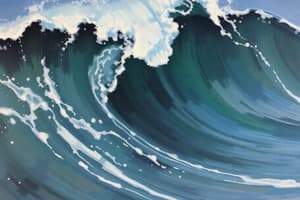Podcast
Questions and Answers
What is the defining characteristic of wave frequency?
What is the defining characteristic of wave frequency?
- The time required for one complete wave cycle to occur.
- The distance a wave travels in a unit of time.
- The number of complete wave cycles passing a point per unit of time. (correct)
- The maximum displacement of a point on the wave from its equilibrium position.
If a wave has a high frequency, what can be inferred about its wavelength?
If a wave has a high frequency, what can be inferred about its wavelength?
- The wavelength will be shorter. (correct)
- The wavelength will be longer.
- There is no direct relationship between frequency and wavelength.
- The wavelength will remain constant, irrespective of frequency.
In the context of light and sound waves, how is frequency perceived?
In the context of light and sound waves, how is frequency perceived?
- Frequency of both light and sound waves is perceived as loudness.
- Frequency of both light and sound waves is perceived as intensity.
- Frequency of light waves is perceived as pitch, and sound waves as color.
- Frequency of light waves is perceived as color, and sound waves as pitch. (correct)
Which statement accurately describes a wave with a low frequency?
Which statement accurately describes a wave with a low frequency?
Considering photons as quanta of light, what is analogous to higher frequency in terms of photon behavior?
Considering photons as quanta of light, what is analogous to higher frequency in terms of photon behavior?
Which of the following describes the relationship between frequency, wavelength, and energy of a wave?
Which of the following describes the relationship between frequency, wavelength, and energy of a wave?
If a wave completes a cycle in 0.5 seconds, what is its frequency?
If a wave completes a cycle in 0.5 seconds, what is its frequency?
How do period and frequency relate to each other in wave characteristics?
How do period and frequency relate to each other in wave characteristics?
Amplitude measurements vary depending on the type of wave. Which unit is most appropriate for describing the amplitude of a sound wave?
Amplitude measurements vary depending on the type of wave. Which unit is most appropriate for describing the amplitude of a sound wave?
Considering visible light and sound waves, what is the relationship between amplitude and frequency?
Considering visible light and sound waves, what is the relationship between amplitude and frequency?
Flashcards
Wave Frequency
Wave Frequency
The number of complete wave cycles that pass a given point in a given time (e.g., per second).
Wavelength
Wavelength
The distance between two corresponding points on adjacent waves, like the distance between two peaks.
High-Frequency Waves
High-Frequency Waves
A wave with high frequency completes more cycles per second.
Low-Frequency Waves
Low-Frequency Waves
Signup and view all the flashcards
Frequency and Color
Frequency and Color
Signup and view all the flashcards
Wave Period
Wave Period
Signup and view all the flashcards
Amplitude
Amplitude
Signup and view all the flashcards
Wave Speed
Wave Speed
Signup and view all the flashcards
Study Notes
Wave Characteristics
- Waves are propagating, oscillating deformations of a medium or quanta. Examples include water waves (transverse), sound waves (compression), and electromagnetic waves (transverse, oscillating electric and magnetic fields, or photons vibrating).
- All waves are characterized by amplitude, frequency, wavelength, speed, and period.
Frequency
- Frequency describes the number of wave cycles occurring per unit of time (e.g., per second).
- High-frequency waves complete more cycles per second, while low-frequency waves take longer.
- In light, frequency correlates to color (higher frequency = violet). In sound, frequency correlates to pitch.
- Frequency is inversely related to wavelength (shorter wavelength = higher frequency).
- Frequency is measured in Hertz (Hz), where 1 Hz = 1 cycle per second.
Wavelength
- Wavelength is the distance between two corresponding points on adjacent waves (e.g., peak to peak).
- Higher frequency waves have shorter wavelengths; lower frequency waves have longer wavelengths.
Speed
- Wave speed is calculated by multiplying wavelength and frequency.
Period
- Period is the time it takes for one complete wave cycle (or for one wave to pass a point).
- Period and frequency are inversely related.
Amplitude
- Amplitude measures the maximum displacement from the rest position of a medium (e.g., peak to the middle/rest position for a transverse wave).
- Higher amplitude indicates greater energy.
- Amplitude units depend on the wave type: distance (meters) for mechanical waves, pressure (Pascals) for sound, and volts per meter (V/m) for electromagnetic waves.
- Amplitude can be described also in terms of brightness (loudness for sound), and intensity (brightness for light).
Amplitude vs. Frequency
- Amplitude and frequency are independent characteristics.
- Waves with the same frequency can have different amplitudes (representing different amounts of energy/intensity). Example: two stars can emit the same frequency (blue light) but one can be brighter. Example: a loud sound and a soft sound can have the same pitch (same frequency).
Studying That Suits You
Use AI to generate personalized quizzes and flashcards to suit your learning preferences.




